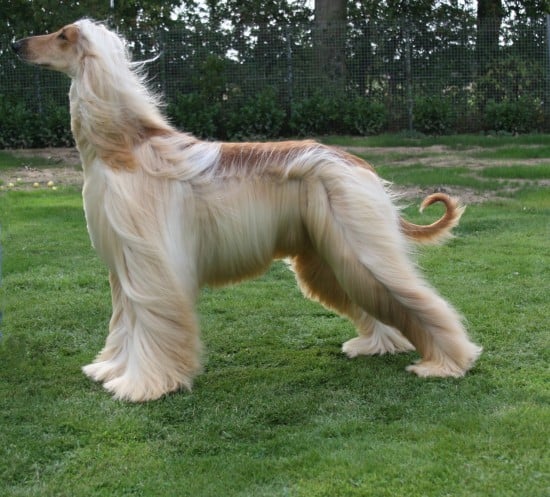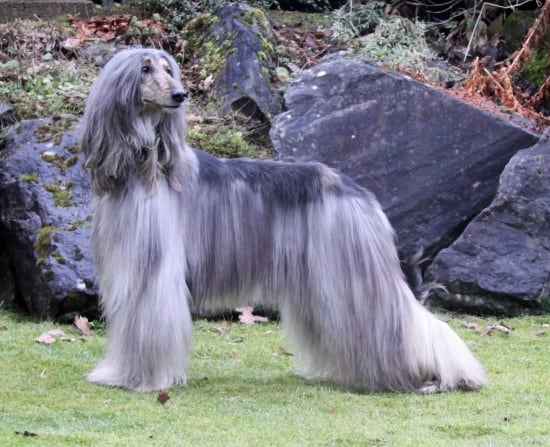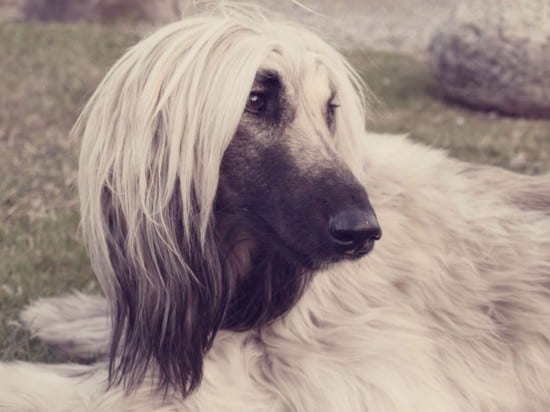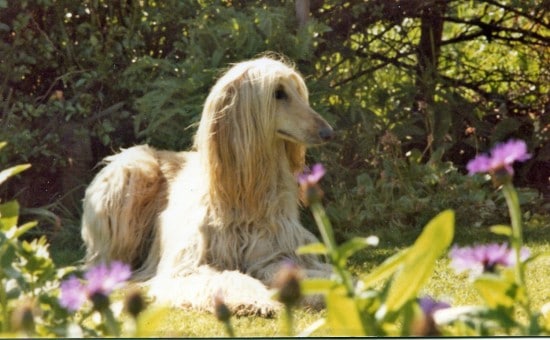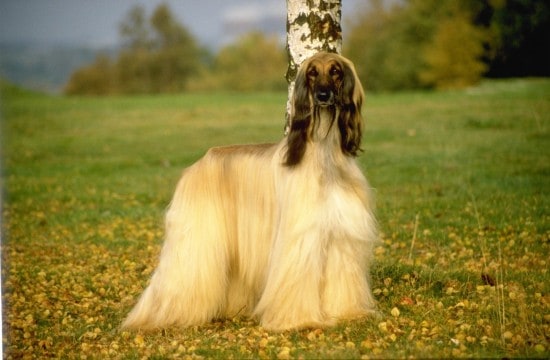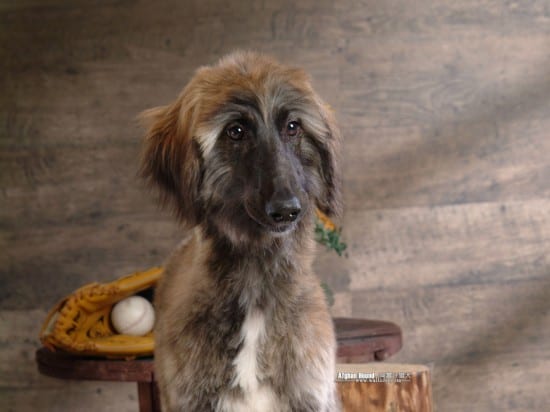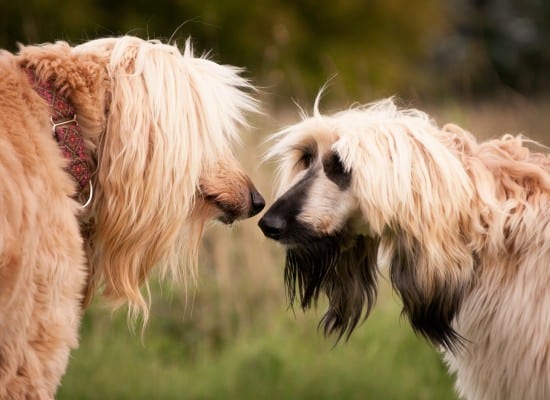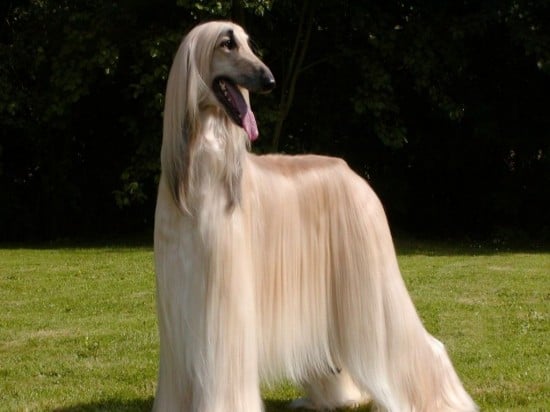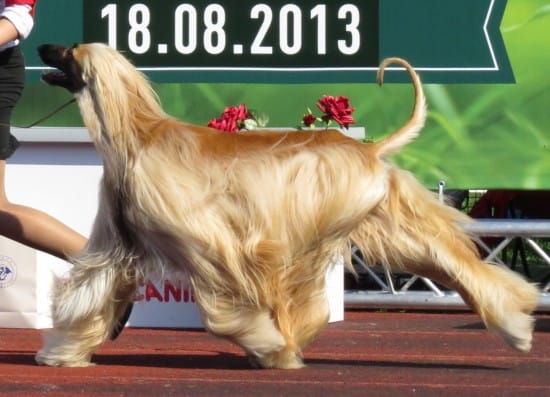The Afghan Hound, with its long, silky coat and regal demeanor, is a breed that stands out in any crowd. Known for its elegance and poise, this breed is neither overly aggressive nor known for its high intelligence; rather, it’s often considered a family-friendly companion.
Typically standing tall with a height ranging from 24 to 29 inches, the Afghan Hound showcases a unique blend of grace and athleticism. While its popularity varies globally, it holds a special place in the hearts of many dog enthusiasts, especially in parts of Europe.
Afghan Hounds are Intelligent Yet Independent: While they’re undoubtedly smart, their independent nature can sometimes come off as aloofness or stubbornness. This trait requires patience and understanding during training sessions.
Regular Grooming is Essential: Their long, flowing coat is one of their defining features, but it demands consistent care. Regular brushing, detangling, and occasional professional grooming sessions are necessary to keep their coat in top condition.
They Have a Strong Prey Drive: Historically sighthounds, Afghan Hounds possess a strong instinct to chase, emphasizing the need for secure fencing and caution during off-leash activities.
Potential Health Concerns: Like many purebreds, Afghan Hounds have certain genetic predispositions. Regular veterinary check-ups and awareness of potential health issues, such as hip dysplasia, are essential for their well-being.
Afghan Hound Breed – Quick Facts
| Feature | Description |
|---|---|
| Size | Large; Height: 24-29 inches (61-74 cm) |
| Weight Range | 50-60 lbs (22.7-27.2 kg); Slight variations between males and females |
| Predominant Colors | Black, Cream, Red, Blue, Brindle, and combinations thereof |
| Fur Length and Type | Long; Silky and Straight |
| Lifespan | 12-15 years |
| Activity Level | Moderate |
| Intelligence Level | Average |
| Ease of Training | Average |
| Good with Kids | With Supervision |
| Training Requirements | Standard |
| Known Health Issues | Cataracts, Hip Dysplasia, Allergies |
Physical Characteristics of the Afghan Hound
The Afghan Hound boasts a statuesque build, typically standing between 24 to 29 inches tall. Males tend to be slightly larger than females, but both genders exhibit a lean and muscular physique, showcasing the breed’s inherent athleticism.
This breed’s coat is one of its most distinctive features. The long, silky fur flows elegantly, providing a luxurious appearance. Recognized coat colors for the Afghan Hound include shades such as black, cream, red, blue, and brindle. Some may also present unique combinations of these colors.
The head of the Afghan Hound is refined and dignified. Its long muzzle is complemented by a pair of expressive eyes, often shaded by a topknot of fur. The ears are pendant-shaped, draping beside the face and often covered in a dense layer of hair.
This breed doesn’t typically have any distinguishing markings, but its overall appearance — from the curve of its tail to its poised stance — is undeniably unique.
As for movement, the Afghan Hound exhibits a fluid gait. Each step is taken with grace and confidence, a testament to its aristocratic roots and agile nature.
Afghan Hound Temperament & Personality
The Afghan Hound’s demeanor is often described as dignified and somewhat aloof. This isn’t a breed that wears its heart on its sleeve. Instead, it possesses a calm and reserved nature, especially around strangers.
When it comes to interactions, the Afghan Hound generally maintains a polite distance with unfamiliar people. However, with its family, this breed can be affectionate and loyal. It’s not uncommon for an Afghan Hound to form a close bond with one particular family member.
As for other dogs and animals, it’s generally sociable but might display a hint of the chase instinct, particularly with smaller pets.
Training an Afghan Hound presents its own set of challenges and rewards. While they’re capable learners, their independent streak can sometimes be mistaken for stubbornness. Sessions should be engaging, with a focus on positive reinforcement to keep their attention.
In terms of energy, the Afghan Hound falls in the moderate range. Daily exercise is essential to keep this breed physically and mentally stimulated. A brisk walk or a short play session in a secure yard often suffices.
Lastly, this breed’s adaptability is noteworthy. Afghan Hounds can thrive in various living situations, be it a spacious house with a yard or an apartment, provided they get their daily exercise.
They generally do well with children, though interactions should be supervised, especially with younger kids. Their long coat and reserved nature also make them less ideal playmates for very energetic children or pets.
What Does The Ideal Home For an Afghan Hound Look Like?
The Afghan Hound, with its elegant appearance and moderate energy levels, requires a living environment that caters to its specific needs. Ideally, a home with a spacious backyard provides ample space for this breed to move and play. However, it’s essential to ensure that the fencing is secure, given the Afghan Hound’s propensity to chase and its agile nature.
Within the household, a setting that balances activity and tranquility suits the Afghan Hound best. Families with both children and elderly members can find this breed to be a gentle companion, but interactions should always be monitored. The Afghan Hound’s long, silky coat can be a tempting plaything for young children, and care should be taken to teach respect for the dog’s boundaries.
Exercise is a non-negotiable aspect of the Afghan Hound’s routine. Access to open spaces, like dog parks or trails, can be beneficial. However, any off-leash activity should be in a secure area to prevent the breed’s chase instinct from taking over.
In terms of resources, proximity to a reputable veterinary clinic is essential, especially considering the breed’s specific health considerations. Access to dog training facilities can also be beneficial, given the breed’s training requirements.
Lastly, the Afghan Hound’s long coat requires consideration in terms of the home environment. Cooler indoor temperatures are more comfortable for this breed.
Can Afghan Hounds be left alone?
Afghan Hounds possess a calm demeanor, but like many breeds, they can exhibit signs of distress if left alone for extended periods. While they aren’t overly clingy, prolonged solitude can lead to feelings of loneliness or boredom for this breed.
When left to their own devices, an Afghan Hound might engage in undesirable behaviors such as chewing or digging. It’s not so much a sign of rebellion but rather an outlet for their pent-up energy or anxiety.
However, with proper training and gradual acclimation, Afghan Hounds can learn to tolerate short periods of alone time. It’s beneficial to establish a routine, ensuring the dog knows when to expect its owner’s departure and return. Additionally, providing engaging toys or puzzle feeders can help keep them occupied and mentally stimulated during these times.
Ideal Owner for an Afghan Hound
The Afghan Hound is a breed that benefits from an owner who understands its unique temperament and needs. Ideally, the owner should have some prior experience with dogs, given the Afghan Hound’s independent nature and specific training requirements.
A lifestyle that accommodates moderate activity is essential for this breed. The Afghan Hound isn’t overly demanding in terms of exercise, but daily walks and occasional play sessions are non-negotiable for their well-being. As such, this breed suits individuals who lead an active lifestyle but also appreciate moments of calm and relaxation.
Training is an integral aspect of owning an Afghan Hound. The breed responds best to consistent training methods that emphasize positive reinforcement.
While they are capable learners, their independent streak might require a bit more patience during training sessions. Hence, an owner willing to invest time in training, with a mix of gentle yet firm guidance, will find the most success.
Time commitment extends beyond training. The Afghan Hound’s luxurious coat demands regular grooming to keep it in top condition. Furthermore, bonding with the dog, ensuring it receives adequate exercise, and attending to its general well-being are all aspects that require dedicated time from the owner.
Are Afghan Hounds good with kids?
Afghan Hounds, with their poised and gentle nature, can be good companions for children. However, their interaction with younger members of the family should be approached with understanding and supervision.
These dogs are typically patient, but their long and flowing coat can be tempting for small children to pull or play with. Teaching children to approach and handle the dog with respect is crucial. It’s essential to ensure that kids understand the dog’s boundaries, avoiding overly boisterous play or any actions that might startle or annoy the dog.
In households with very young or energetic children, close supervision is recommended during interactions. The Afghan Hound’s calm demeanor is best suited to older children who can understand and respect the dog’s nature.
Are Afghan Hounds aggressive?
By nature, Afghan Hounds are not typically aggressive dogs. They are known for their aloofness and dignity, often maintaining a reserved demeanor, especially around strangers. However, it’s essential to differentiate between true aggression and behaviors that might arise from other factors.
Like any breed, individual Afghan Hounds might display protective instincts, especially if they perceive a threat to their family or territory. Early socialization is crucial to ensure that the dog becomes well-adjusted and can differentiate between genuine threats and benign situations.
Certain triggers, such as unfamiliar stimuli or sudden movements, might provoke a reaction in some Afghan Hounds. Being aware of these triggers and managing introductions to new experiences in a controlled manner can help mitigate any reactive tendencies.
Furthermore, their inherent chase instinct might be misconstrued as aggression, especially when they’re around smaller animals. It’s essential to understand that this behavior is instinctual and not necessarily a sign of hostility.
How Popular Is This Breed?
The Afghan Hound holds a distinctive place in the canine world, recognized for its luxurious coat and regal presence. In terms of global popularity, it sees fluctuating interest. Historically, this breed has enjoyed moments of high demand, often influenced by media appearances or endorsements by public figures.
In the USA, the Afghan Hound is moderately popular. While it’s not topping the charts of the most adopted breeds, it maintains a steady presence in American households. Enthusiasts and breed aficionados appreciate the Afghan Hound for its unique appearance and temperament, making it a favored choice for dog shows and competitions.
Certain regions in Europe, particularly the UK and parts of Eastern Europe, have shown a consistent interest in the Afghan Hound. The breed’s history and origins, coupled with its distinctive appearance, contribute to its appeal.
Afghan Hound Grooming
The Afghan Hound’s majestic coat is one of its most recognizable features, but it also demands dedicated grooming to maintain its splendor. Regular grooming not only ensures the coat looks its best but also promotes the dog’s overall health.
The length and texture of the Afghan Hound’s coat necessitate frequent brushing, ideally several times a week. Using a pin brush, owners should gently work through the coat, ensuring that tangles and mats are carefully removed. Starting from the head and working down to the tail allows for a systematic approach.
Specific grooming tools, like wide-toothed combs, can help in detangling areas prone to matting, such as behind the ears or under the legs. When it comes to bathing, a gentle dog shampoo and conditioner, preferably one designed for long-haired breeds, can help keep the coat silky and manageable.
While regular home grooming is essential, periodic visits to a professional groomer can be beneficial. They can assist with tasks like trimming the hair around the eyes and ears, ensuring the dog’s comfort and visibility.
However, grooming isn’t just about the coat. Owners should also regularly check the Afghan Hound’s ears, teeth, and nails, ensuring they remain clean and healthy.
One challenge that some owners might encounter is the dog’s sensitivity to grooming. The Afghan Hound, with its dignified demeanor, might be averse to prolonged grooming sessions. It’s essential to make the experience as calm and positive as possible, using treats and gentle reassurance to keep the dog at ease.
Do Afghan Hounds shed?
Afghan Hounds, with their long, flowing coats, do shed, but the shedding pattern is not as pronounced as in some other breeds. They typically exhibit a lower frequency of shedding, which can be seasonal in nature, aligning with changes in the weather.
While the amount of hair they lose might not be excessive, the length of the fur means that when they do shed, it can be quite noticeable. Regular brushing, as previously mentioned, not only helps maintain the health and appearance of the coat but also effectively manages and reduces the amount of hair that gets shed around the home.
Afghan Hound Diet: What Do They Eat?
The Afghan Hound’s dietary needs are influenced by factors like age, weight, activity level, and overall health. Generally, a balanced diet that provides all the essential nutrients is pivotal for their well-being.
Most Afghan Hound owners opt for high-quality commercial dog food, whether kibble or wet food. It’s essential to select a product that aligns with the dog’s life stage, from puppy to adult to senior. For instance, puppies require food that supports their rapid growth, while seniors might benefit from diets that cater to joint health and metabolism.
Afghan Hounds, like all breeds, can have specific dietary sensitivities or allergies. Common allergens include certain proteins or grains. If an Afghan Hound shows signs of food intolerance, such as skin issues or digestive upset, consulting a vet to pinpoint the cause and adjust the diet accordingly is recommended.
Treats can be a valuable tool for training and bonding, but they should be given in moderation. It’s essential to choose treats that complement the dog’s main diet and don’t contribute to excessive weight gain. Foods like chocolate, grapes, onions, and certain artificial sweeteners are toxic to dogs and should be avoided entirely.
How to Feed an Afghan Hound
Feeding an Afghan Hound requires understanding the breed’s specific needs and adjusting practices to ensure optimal health. It starts with selecting an appropriate bowl. Given the Afghan Hound’s long muzzle, deeper bowls might be more comfortable for them, allowing easy access to their food.
Consistency is key when establishing a feeding routine. Regular feeding times, typically twice a day for adults, can help regulate the dog’s metabolism and prevent overeating. Mealtimes should be in a quiet, designated area where the dog can eat without distractions or disturbances.
While free-feeding, where food is left out all day for the dog to eat at will, might seem convenient, it’s not recommended for Afghan Hounds. Scheduled meals allow owners to monitor food intake closely, ensuring the dog gets the right amount and any changes in appetite are noted.
Water should always be readily available. Fresh, clean water must be provided in a separate bowl, and it’s crucial to check and refill it regularly, especially after exercise or on hot days.
How Much to Feed an Afghan Hound
Determining the right amount of food for an Afghan Hound hinges on various factors, including the dog’s age, weight, activity level, and overall health. Generally, the feeding guidelines provided on commercial dog food packaging offer a good starting point. However, individual needs might differ, and it’s essential to monitor the dog’s condition and adjust portions accordingly.
For an adult Afghan Hound with average activity levels, the daily food intake might range between 2 to 2.5 cups of high-quality dry kibble. Puppies, with their rapid growth and high energy levels, might require more frequent feedings with specially formulated puppy food. On the other hand, senior Afghan Hounds, or those with reduced activity, might need slightly less food to prevent weight gain.
Health Considerations
Afghan Hounds, with their graceful appearance and regal demeanor, are generally a healthy breed. However, like all dog breeds, they are predisposed to certain health conditions.
One of the common concerns in Afghan Hounds is hip dysplasia, a genetic condition where the thigh bone doesn’t fit snugly into the hip joint. Early detection and appropriate management can help alleviate the discomfort associated with this condition.
Cataracts, which can cause cloudiness in the eye lens, leading to decreased vision, might also be observed in some Afghan Hounds. Regular veterinary eye exams can help in early detection and treatment.
Another condition to be aware of is chylothorax, where lymphatic fluid accumulates in the chest cavity. While the causes can vary, early diagnosis and appropriate medical intervention are crucial.
The breed’s long, floppy ears make them susceptible to ear infections. Regular cleaning and checking for signs of infection, such as redness, swelling, or an unpleasant odor, are essential.
Given these potential health concerns, regular veterinary check-ups are paramount. These check-ups can help in early detection of issues, ensuring timely intervention and the best possible care for the Afghan Hound.
How much exercise do Afghan Hounds need?
Afghan Hounds are a breed that exudes elegance, but beneath their poised exterior lies a dog with considerable energy and agility. Proper exercise is essential to cater to their physical and mental well-being.
Typically, Afghan Hounds require a moderate amount of daily exercise. This can be achieved through a combination of brisk walks, play sessions, and opportunities to run in a secure area. Their history as hunting dogs means they have a strong chase instinct, and they relish the opportunity to sprint, showcasing their speed and grace.
While walks are beneficial, Afghan Hounds truly thrive when given a chance to stretch their legs in an open space. A securely fenced yard or dog park can be ideal for this. However, it’s essential to ensure the area is safe and escape-proof, given their propensity to chase.
Mental stimulation is just as crucial for Afghan Hounds. Activities like agility training or fetch can keep their minds engaged and provide an additional outlet for their energy.
It’s essential to be aware of the breed’s long coat when exercising, especially in warmer climates. Overexertion in the heat can lead to overheating. Ensuring they have access to fresh water and shade during outdoor activities can help mitigate this risk.
Afghan Hound Training
Training an Afghan Hound can be a unique experience. These dogs are known for their independence and intelligence, which means they can be both eager learners and occasionally stubborn. Knowing how to approach their training is essential for a harmonious relationship.
Starting training early is beneficial. As puppies, Afghan Hounds are more impressionable and can absorb basic commands like “sit,” “stay,” and “come” with ease. Consistency is key, as these dogs respond best to regular training sessions that follow a set pattern.
Socialization is another critical aspect of training for Afghan Hounds. Given their hunting background and strong prey drive, they can sometimes be aloof or wary of unfamiliar animals or situations. Exposing them to various environments, people, and animals during their formative months can help mold them into well-rounded adults.
While Afghan Hounds are intelligent, their independent nature might sometimes come across as aloofness or stubbornness during training sessions. Using positive reinforcement methods, like treats or praise, can motivate them. Harsh corrections or punitive measures are not effective and can damage the trust between the dog and the handler.
For those looking to challenge their Afghan Hounds further, advanced training in activities like agility or lure coursing can be fulfilling. These activities tap into the breed’s natural abilities and provide both mental and physical stimulation.
House training an Afghan Hound follows the general principles of consistency, routine, and positive reinforcement. Given their sensitivity, it’s essential to approach any accidents with patience and understanding.
Are Afghan Hounds easy to train?
When it comes to training, Afghan Hounds present a unique blend of intelligence and independence. Their keen intellect means they can quickly grasp commands and tricks. However, their independent streak can sometimes be mistaken for stubbornness or aloofness.
For those familiar with dog training, the challenge posed by an Afghan Hound can be rewarding. They respond best to training methods that employ positive reinforcement. Treats, praise, and play can be effective motivators for these dogs. On the flip side, harsh methods or negative reinforcement can often backfire, leading to a disinterested or even distrustful dog.
Consistency is another crucial factor in training an Afghan Hound. Given their tendency to think for themselves, setting clear boundaries and being consistent in reinforcing them can help in ensuring training success.
Are Afghan Hounds smart dogs?
Afghan Hounds are undoubtedly intelligent, but their intelligence manifests differently compared to some other breeds. While they might not always rank at the top in traditional obedience-based intelligence tests, their cognitive abilities are nuanced and deeply rooted in their history as hunting dogs.
Their keen senses, especially sight, make them exceptional sighthounds. They were bred to spot, chase, and catch prey over rugged terrains, requiring not just physical agility but also sharp decision-making and problem-solving skills. When on the hunt, they had to make split-second decisions, showcasing their inherent intelligence.
However, this hunting intelligence also comes with a degree of independence. In domestic settings, this can sometimes be interpreted as aloofness or stubbornness. For instance, while an Afghan Hound may understand a command perfectly well, they might choose to follow it on their own terms or when they see a benefit in doing so.
Their intelligence is also evident in their ability to navigate complex social situations. Afghan Hounds are known to form strong bonds with their families and can be adept at reading human emotions and responding to them.
What are the drawbacks of Afghan Hounds?
Like every breed, Afghan Hounds come with their own set of challenges that potential owners should be aware of. Their elegant appearance and regal demeanor can be deceiving, masking some of the breed-specific quirks that might pose challenges to unprepared owners.
One of the primary behavioral challenges with Afghan Hounds is their strong prey drive. This trait, inherited from their hunting ancestors, means they can be prone to chasing moving objects, whether it’s a squirrel in the yard or a car on the street. This behavior underscores the importance of secure fencing and leashed walks.
From a health perspective, Afghan Hounds, like many purebreds, have certain genetic predispositions. Conditions like hip dysplasia or cataracts can be of concern, necessitating regular veterinary check-ups and potential future medical expenses.
Grooming is another area where Afghan Hounds can be deemed high-maintenance. Their long, flowing coat, while stunning, requires regular attention to prevent matting and tangling. This commitment might be cumbersome for some owners, especially those unfamiliar with the intricacies of dog grooming.
Lastly, their independent nature, often mistaken for aloofness, can sometimes pose training challenges. They’re intelligent but on their terms. This means traditional training methods might not always yield instant results, requiring patience and adaptability from the owner.
Popular Afghan Hound Mixed Breeds
The allure of mixed breeds often lies in the combination of desirable traits from both parent breeds. When it comes to the Afghan Hound, its elegance, intelligence, and unique coat make it an intriguing choice for crossbreeding. While the outcome of mixed breeding can be unpredictable, some Afghan Hound mixes have gained popularity due to their distinctive appearances and temperaments.
One such mix is the Afador, a blend of the Afghan Hound and the Labrador Retriever. This mix often results in a dog with the luscious coat of the Afghan Hound combined with the friendly and outgoing nature of the Labrador. They tend to be energetic, loyal, and often inherit the Afghan’s independent streak.
The Afghan Collie, a mix of Afghan Hound and Border Collie, is another interesting blend. This mix combines the intelligence and agility of the Border Collie with the elegance and demeanor of the Afghan Hound. Owners of this mix often report a highly intelligent and active dog, eager to engage in physical and mental exercises.
Another notable mix is the Afghan Spaniel, a combination of the Afghan Hound and the Cocker Spaniel. This mix often results in a medium-sized dog with a wavy coat and a friendly disposition. They tend to be playful, affectionate, and can be a great fit for families.

